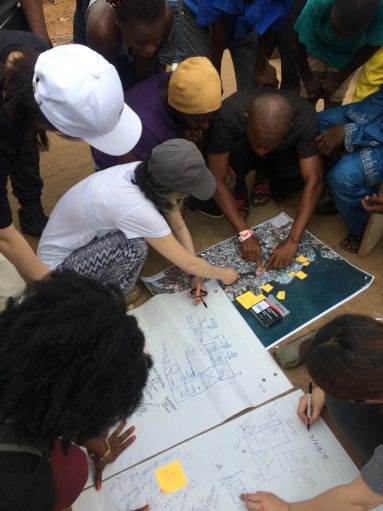Living at risk in Freetown
By Adriana E Allen, on 4 May 2018
Authors: Leong, Matilda; Vo, Son Nam; Kim, Hayeon; Korsi Simpson, Paul; Korsi Simpson, Peter and Allen, Adriana (Cockle Bay Group from the ESD MSc practice module)
In the early hours of Wednesday, 25 April 2018, the residents of Kola Tree in Cockle Bay were awakened to the shouts of fire. The blaze took place in the informal settlement located in the Western coast of Freetown and affected 97 people. Although there were no casualties reported, rampant loss of property, possessions and livelihoods were claimed by the incident.
When the team from Development Planning Unit (DPU) at University College London (UCL) and Sierra Leone Urban Research Centre (SLURC) arrived at the site, they were met with chaos. A crowd of residents were still dealing with the aftermath of the fire over the rubbles of their corrugated metal sheet homes. Despite all effort to mitigate damages, the flames had been eventually extinguished by burying them under the collapsing building structures.

Photo by S.N. Vo
It was soon established that the Cockle Bay community was left on its own to undertake responsive actions. There were minimal external interventions save for the fire brigade who attempted to extinguish the fire alongside the residents. The DPU/SLURC team quickly came to the support of the residents by conducting an enumeration process to determine who was affected and what was the impact of the fire.
This information was subsequently handed to the local leader of the Federation of the Urban and Rural Poor (FEDURP) and of the Community Based Disaster Risk Management Committee to facilitate the provision of relief for victims and temporary shelter for the night. While the source of the fire was yet to be determined, the rapid assessment conducted by partners on the ground speculated the possibility of an electrical fault. The Office of National Security (ONS) responded hours after the event and is reportedly conducting a more detailed assessment to identify the origin of the fire.

DPU team supporting the enumeration of those affected by fire in Cockle Bay. Photo by A. Allen.
The absence of external support during small-scale disasters is not unusual for informal settlements. In most circumstances, external actors such as governmental institutions and non-governmental organisations have to conserve their limited resources. Consequently, they can only respond to severe incidents. For example, a prominent local NGO was only able to support 144 of the 2,048 victims during the 2015 fire in Susan’s Bay due to the lack of funding. Minor disasters such as that in Cockle Bay accordingly tend to be overlooked and underreported. Moreover, dismal planning characterised by limited road access and dispersed and insufficient water sources also hinder evacuation and relief efforts and exacerbate the everyday risks facing local communities. Moreover, although preliminary relief is given to the victims of disasters, this is often insufficient to ensure that those affected can recover from such events, let alone to escape risk accumulation and poverty cycles.
It is estimated that about 547 fires outbreaks affected those living in informal settlements in Freetown between 2011 to 2015 (Di Marino et al, 2018). Fires are only one of the multiple hazards facing poor and impoverished women and men in the city on a regular basis. Other hazards include floods, mudslides, landslides, waterborne diseases, and occupational hazards, amongst others. Each of these disasters, small and large-scale, disproportionately impact the urban poor – destroying their housing, disrupting their education and in some case, even terminating their sources of livelihood.

Photo by S.N. Vo
The fire outbreak in Cockle Bay brings to light the broader issue of prolonged systematic oversight of informal settlements and the invisibility of certain segments of the city population, such as tenants. As the fire was confined to a mere 8 compounds within a small area of about 100m2, initial estimates speculated that about 20 people had being affected. However, the enumeration process conducted by the team in collaboration with local residents revealed that it was in fact a total of 97 people, a third of whom were children. About 80% of the victims were tenants. This yields an abrupt indication of how vulnerable groups such as tenants and the youth in households are often inadvertently not accounted for, leaving them virtually invisible by the community themselves in times of disasters.
Lacking the means to enter the housing and land markets elsewhere in the city, many women in men are forced to reside in informal settlements like Cockle Bay. Therefore, these areas have experienced consistent densification and land reclamation over the years, particularly since the Civil War. Aside from high housing densities, most informal settlements also face scarce provision of basic services. Communities are forced to utilise improvised infrastructures, causing overloading of electrical points. In the area affected by the blaze, all 34 families relied on two metered connections for electricity.

Everyday life in Cockle Bay. Photo by: A. Allen
Some might posit that informal settlements are hazards in themselves and ought to be eradicated. However, these settlements house a sizeable proportion of Freetown’s population, with no alternative dwelling options. Moreover, their residents perform jobs that support the daily functioning of Freetown; quietly they run the city. Demolishing their living quarters as a ‘protective measure’ against risk simply displaces the issue – disrupting lives, livelihoods, family ties and social organisations – making poor women and men even more invisible. Events like the fire in Cockle Bay remind us of the need to stop blaming the victims and victimising the poor, the need to acknowledge that they live at risk not as an exception but as a common reality, the need to seek pathways for more inclusive urbanisation beyond risk.
Reference
Di Marino, Marco; Lacroix, Lea; Nastoulas, Illias; Simpson, Paul; Trintafillides, Georgina; Williams, Cai Anwyl ; and Yang, Deyu. (2018) Urban Risk Trap: Fire Dynamics in Freetown’s Informal Settlements. Policy Brief No. 2. SLURC/DPU Action-Learning Alliance.
 Close
Close




